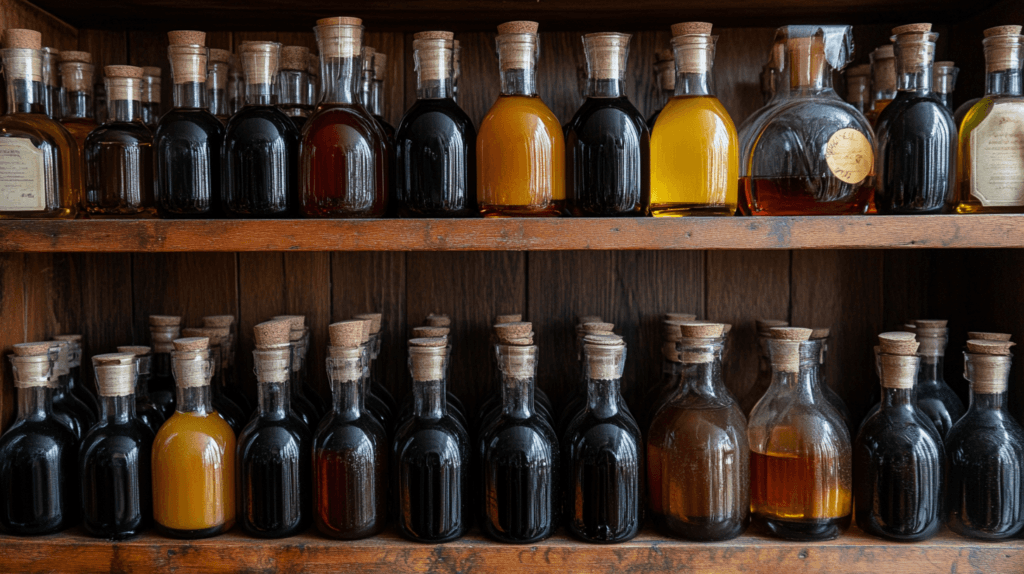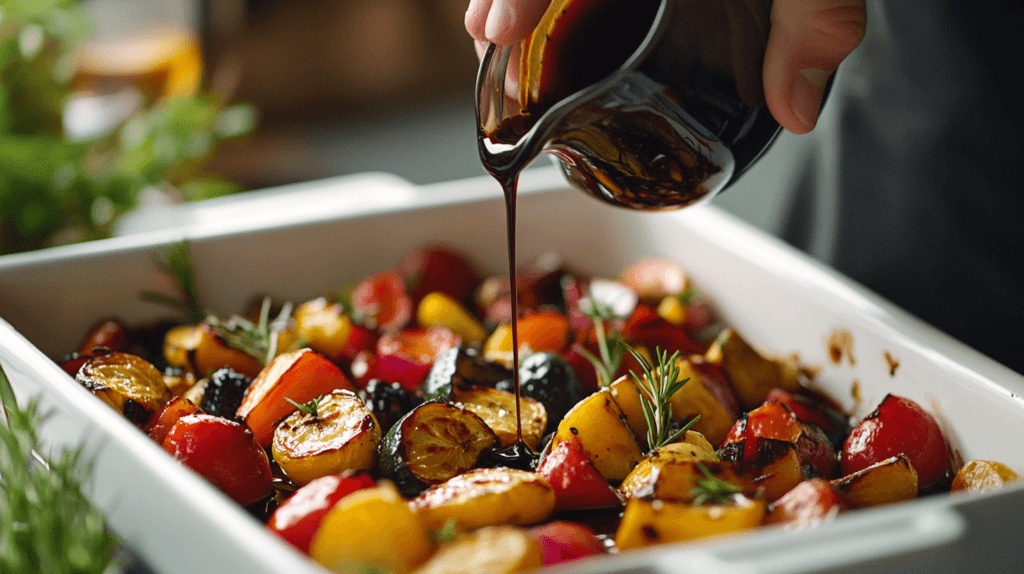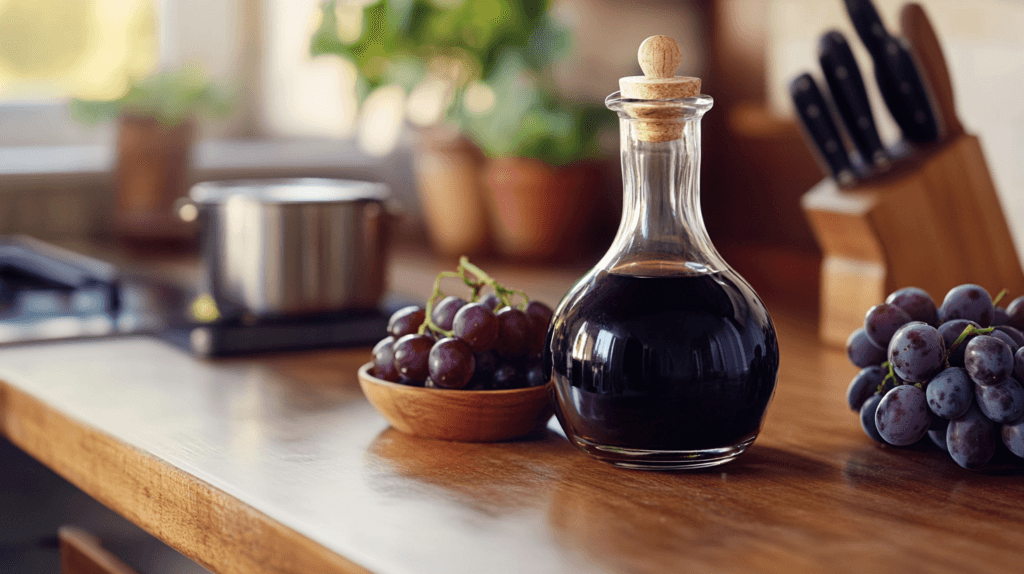Balsamic vinegar is a kitchen staple, known for its deep flavor and versatility. Whether drizzled on salads, used in marinades, or added to desserts, it enhances many dishes. But Does balsamic vinegar have alcohol? This guide explores its production, ingredients, and whether traces of alcohol remain after fermentation. If you’re curious about dietary restrictions, health concerns, or culinary uses, read on to uncover the facts.
Table of Contents
Understanding Balsamic Vinegar
What is Balsamic Vinegar?
Balsamic vinegar is a concentrated and aged vinegar originating from Italy, specifically the Emilia-Romagna region. Known for its distinct production process, balsamic vinegar sometimes prompts questions about whether it contains alcohol. Made from grape must—a mixture of freshly crushed grape juice, including the skins, seeds, and stems—it stands out with its syrupy texture, deep color, and a complex flavor profile that balances sweetness and acidity.
There are three main types of balsamic vinegar:
- Traditional Balsamic Vinegar: Made using time-honored methods, this variety is aged for 12 to 25 years and boasts the highest quality.
- Commercial Balsamic Vinegar: A more affordable option, typically containing additives like caramel and thickeners to mimic traditional qualities.
- Condiment-Grade Balsamic Vinegar: A hybrid of traditional and commercial varieties, often used in gourmet cooking.
How is Balsamic Vinegar Made?
The production of balsamic vinegar begins with cooking grape must, which is then fermented and aged. The process involves:
- Cooking the Must: Grapes are simmered to concentrate the sugars and develop a rich flavor.
- Fermentation: Natural yeast converts the sugars into alcohol, and acetic acid bacteria transform the alcohol into acetic acid, the key component of vinegar.
- Aging: The vinegar is aged in wooden barrels, allowing it to develop complex flavors. During this time, any residual alcohol is converted or evaporated.
Ingredients in Balsamic Vinegar
The primary ingredient in balsamic vinegar is grape must, which is essential to its rich flavor. However, some commercial varieties may include wine vinegar, caramel coloring, and preservatives, raising questions about the presence of alcohol. Traditional balsamic vinegar, in contrast, contains no additives and relies solely on the natural aging process to develop its signature taste.
Traditional Balsamic Vinegar:
- Authentic Ingredients: Made solely from cooked grape must with no additives.
- Aging Process:
- Aged for 12 to 25 years in barrels of different woods (e.g., oak, cherry, chestnut).
- The gradual evaporation concentrates the flavors, and the interaction with the wood enhances complexity.
- Protected Origin:
- Designated by labels like Aceto Balsamico Tradizionale di Modena DOP or di Reggio Emilia DOP, ensuring adherence to strict guidelines.
- Authentic traditional balsamic is produced only in Modena or Reggio Emilia, Italy.
- Flavor Profile:
- Sweet, tangy, and balanced, with layers of flavor from the aging process.
- Syrupy texture due to natural sugars.
- Cost and Availability:
- Premium pricing reflects the time and effort required.
- Often sold in smaller quantities.
Commercial Balsamic Vinegar:
- Simpler Ingredients: Typically a blend of grape must and wine vinegar, with additives like caramel for color and thickeners for texture.
- Quick Production:
- Aged for months or a few years at most.
- Industrial processes focus on quantity over quality.
- Flavor Profile:
- Sharper acidity and less sweetness than traditional vinegar.
- Lacks the depth and complexity of traditional varieties.
- Price and Accessibility:
- Mass-produced for affordability.
- Widely available in supermarkets.
- Labeling:
- May be labeled as Aceto Balsamico di Modena IGP, indicating a lower grade but still of Italian origin.
Comparison of Uses:
- Traditional Balsamic Vinegar:
- Best used as a finishing touch (e.g., drizzled over fruit, cheeses, or premium dishes).
- Its delicate and layered taste is ideal for savoring on its own.
- Commercial Balsamic Vinegar:
- Suitable for salad dressings, marinades, and recipes requiring larger quantities.
- More cost-effective for everyday cooking.
Differences Between Traditional and Commercial Balsamic Vinegars

- Traditional Balsamic Vinegar:
- Made exclusively from grape must.
- Aged in wooden barrels for 12 to 25 years.
- Rich and complex flavor with no additives.
- Expensive due to time and craftsmanship.
- Commercial Balsamic Vinegar:
- Made from grape must mixed with wine vinegar.
- Often includes caramel coloring, thickeners, and preservatives.
- Less aged (a few months to a couple of years).
- More affordable but lacks the nuanced flavor of traditional vinegar.
- Taste and Usage Comparison:
- Highlight when to use traditional vs. commercial balsamic vinegar based on recipes and budgets.
Alcohol Content in Balsamic Vinegar
Does balsamic vinegar have alcohol?
During fermentation, the natural sugars in grape must initially produce alcohol. However, this alcohol converts into acetic acid over time, which gives vinegar its tangy taste. By the time balsamic vinegar is bottled, any remaining alcohol is either negligible or fully evaporated.
Alcohol in Traditional vs. Commercial Varieties
Traditional balsamic vinegar, made without shortcuts, is unlikely to contain measurable amounts of alcohol. However, commercial varieties may include additives such as wine vinegar, which could contain trace amounts of residual alcohol. These traces are usually well below levels that would have any physiological effect.
Can Balsamic Vinegar Ferment Further?
In rare cases, improper storage or contamination could cause balsamic vinegar to ferment further, potentially resulting in small amounts of alcohol. Storing it properly in a cool, dry place helps prevent this.
Safety and Dietary Concerns
Is Balsamic Vinegar Halal or Kosher?
Many people following Halal or Kosher diets wonder if balsamic vinegar is permissible. Traditional balsamic vinegar is usually acceptable since any alcohol from fermentation converts into acetic acid. However, some commercial varieties contain added wine vinegar, which may be a concern. Always check labels or choose certified Halal or Kosher options for assurance.
Is It Safe for Pregnant Women?
Balsamic vinegar, a concentrated and aged vinegar originating from Italy, is cherished for its unique qualities. Made from grape must—a mixture of freshly crushed grape juice, including the skins, seeds, and stems—it is a culinary staple with a syrupy texture, deep color, and complex flavor profile. But have you ever wondered if balsamic vinegar contains alcohol? This question often arises due to its fermentation process and its widespread use in cooking and gourmet dishes.
Does Balsamic Vinegar Affect Blood Alcohol Levels?
The alcohol content in balsamic vinegar, if present, is so minimal that it would not affect blood alcohol levels. Even with commercial varieties that include wine vinegar, the concentration is extremely low and would have no physiological impact. This makes balsamic vinegar safe for those concerned about sobriety or legal alcohol limits.
Culinary and Health Benefits of Balsamic Vinegar

Why Use Balsamic Vinegar in Cooking?
Balsamic vinegar’s rich, tangy flavor adds depth to various dishes, making it a favorite among chefs and home cooks alike. But have you considered whether balsamic vinegar contains alcohol and how that might affect its culinary uses? Here are a few common applications where this flavorful vinegar shines:
- Salad Dressings: A classic choice for vinaigrettes.
- Marinades: Enhances the flavor of meats, seafood, and vegetables.
- Desserts: A drizzle over fresh fruits or ice cream provides a unique contrast of flavors.
- Glazes and Reductions: Thickened balsamic vinegar works well as a glaze for roasted dishes.
Its versatility and ability to balance sweetness and acidity make it an indispensable ingredient in kitchens worldwide.
Health Benefits of Balsamic Vinegar
Beyond its culinary uses, balsamic vinegar offers several health benefits:
- Rich in Antioxidants: Derived from grapes, it contains antioxidants that combat free radicals.
- Supports Digestion: Acetic acid promotes healthy gut bacteria and aids digestion.
- Lowers Cholesterol: Some studies suggest it may help reduce bad cholesterol levels.
- Regulates Blood Sugar: Its glycemic index is low, making it suitable for diabetics when consumed in moderation.
These benefits make balsamic vinegar more than just a flavorful addition to meals—it’s also a functional food with properties that promote overall health. However, understanding whether balsamic vinegar contains alcohol is important for those with specific dietary preferences or restrictions.
How to Store and Maintain the Quality of Balsamic Vinegar
Optimal Storage Conditions:
- Temperature:
- Keep at room temperature, ideally between 10°C and 20°C (50°F to 68°F).
- Avoid exposing the bottle to extreme heat or cold.
- Light Protection:
- Store in a dark place, such as a pantry or cupboard, to shield it from sunlight.
- Ultraviolet light can degrade the vinegar’s flavor and quality over time.
- Humidity and Air Control:
- Ensure the bottle is tightly sealed to prevent evaporation or contamination.
- Store away from areas of high humidity to avoid mold growth on the cap or container.
Shelf Life Recommendations:
- Traditional Balsamic Vinegar:
- Indefinite shelf life if stored correctly due to its natural acidity, which acts as a preservative.
- Quality may improve with further aging, although the rate slows significantly in the bottle.
- Commercial Balsamic Vinegar:
- Best consumed within 3-5 years for optimal taste.
- Over time, additives may degrade, leading to diminished flavor and quality.
Signs of Degradation:
- Changes in Appearance:
- Cloudiness or sediment at the bottom of the bottle (usually harmless but indicative of aging issues).
- Altered Flavor or Aroma:
- A sharp or unpleasant odor may suggest improper storage.
- Loss of characteristic sweetness or tanginess.
- Separation:
- For flavored or blended varieties, separation in the liquid may indicate spoilage.
Common Mistakes to Avoid:
- Improper Sealing:
- Leaving the bottle open or not sealing it tightly can cause the vinegar to oxidize, altering its taste.
- Storage Near Heat Sources:
- Avoid placing the bottle near stoves, ovens, or microwaves, where heat exposure accelerates evaporation and degrades quality.
- Refrigeration:
- Refrigeration is unnecessary and can cause crystallization or a change in texture.
Tips for Maintaining Quality:
- Use an Airtight Cap: Replace damaged caps to maintain a tight seal.
- Avoid Contamination: Use a clean spoon or pour the vinegar directly to prevent introducing contaminants.
- Store Upright: Keep the bottle upright to reduce contact with the cap, which can degrade over time.
FAQs About Balsamic Vinegar and Alcohol
Does Cooking with Balsamic Vinegar Remove Alcohol?
Yes, cooking balsamic vinegar eliminates any trace of alcohol, as heat causes it to evaporate. This makes it safe for those avoiding alcohol while still enhancing the flavor of dishes. This makes it a great choice for recipes like this balsamic chicken dish, where the vinegar’s tangy richness shines.
Can Children Consume Balsamic Vinegar?
Absolutely! Balsamic vinegar is safe for children to consume because the alcohol content is negligible. Its sweet and tangy flavor is a delightful way to introduce young palates to more complex tastes. For an even healthier twist on family meals, pair balsamic vinegar with nutritious recipes like fresh salads or protein-rich dips to encourage balanced eating.
How Long Does Balsamic Vinegar Last?
Balsamic vinegar has an impressive shelf life, especially when stored properly. Traditional varieties can last indefinitely, while commercial ones usually remain good for 3-5 years. For tips on proper storage, check out how to keep balsamic vinegar fresh. Additionally, ensure your pantry staples like dairy products stay fresh by following advice like these cottage cheese storage tips.
Conclusion
Balsamic vinegar is a flavorful, versatile ingredient with minimal to no alcohol content due to fermentation. Traditional varieties are alcohol-free, while some commercial versions may contain trace amounts. For those with dietary concerns, checking labels or choosing certified options ensures peace of mind. Whether for cooking, salads, or marinades, balsamic vinegar remains a delicious and safe choice for most diets.
Whether you drizzle it over salads, marinate your proteins with it, or incorporate it into recipes like balsamic chicken, this condiment is sure to elevate your meals. With proper storage, balsamic vinegar can last for years, providing rich, tangy goodness for a wide array of dishes.

